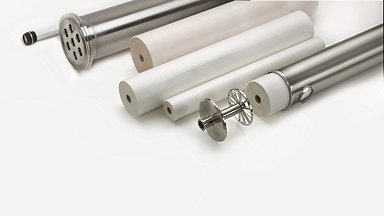Membrane filtration solutions for dairy, plant-based and alternative ingredient products
Membrane filtration supports efficient production of milk- and whey-based foods and beverages as well as high-value nutrients for infants, sports people, and seniors. It is also used to concentrate plant-based proteins and to purify alternative proteins.
Membrane filtration also facilitates process water recovery and reuse, meeting high-quality standards. Traditional food processing often results in wastewater being dismissed down the drain. But with membrane filtration, it can be reused for equipment cleaning or even in food processes where it has direct contact with the product itself. Treated water can surpass even drinking water standards in some regions.

Expert advice on membrane filtration
How we do business with you
What can you expect from us when you enquire for a membrane filtration system? Let’s show you our process. To put it simply, you can expect us to deliver the best solution for your needs.
Transportation and cost savings
Transport and cost savings are a top priority for the dairy and food industry. So, how do you achieve these savings? One option is water removal from products by using membrane filtration.
Gain more value from your whey process
Processing of whey from cheese manufacturers is one of the most common membrane filtration applications in the dairy industry. Our expert explains how you get the most of your whey.
Achieve high levels of protein without additives
High-protein product like skyr, Greek yoghurt, labneh and quark are seen as superfoods by many health-conscious consumers. Learn how to achieve high-protein levels without adding milk protein powder.
Extend shelf life in premium milk
Our bactocatch solution removes 99,9999% of bacteria and spores in milk, using a ceramic membrane filtration unit and HTT (high-temperature treatment) of cream. You can use the unit for efficient removal of bacteria and spores in chilled milk and in cheese milk to obtain premium quality end products.
How to ensure efficient operation of your membrane filtration system
How do you get the most out of raw materials, keep operating costs down, and minimise the environmental footprint? One answer is our membrane filtration service.
Our membrane expertise
Membranes are key to the performance of your membrane filtration system. We know how to help you find the right membranes for your products, and we source from all suppliers.
See a spiral-wound membrane unit in action
We use the example of protein concentration for high-protein products, which is one of the most common membrane filtration applications.
Explore the unique benefits of spiral-wound membranes
Spiral-wound membrane filtration is a key technology behind innovative food solutions. See how feed components are separated to let food producers put them together again in new ways (and make new products).
Membrane filtration processes
Within the dairy industry, four different membrane filtration processes are used: microfiltration (MF), ultrafiltration (UF), nanofiltration (NF), and reverse osmosis (RO). The figure illustrates which milk and whey components can be concentrated by means of each process, depending on the density of the membrane.
Enhance production with membrane filtration
Are you innovating in food and beverage creation or focusing on product quality and production flexibility? Membrane filtration is the key.
Facing challenges like rapid product launches, quality maintenance, operational efficiency, and sustainable production for revenue growth, we understand your complexities.
Explore our engineered filtration solutions for both line and stand-alone applications, ensuring increased yield and maximum uptime.
























